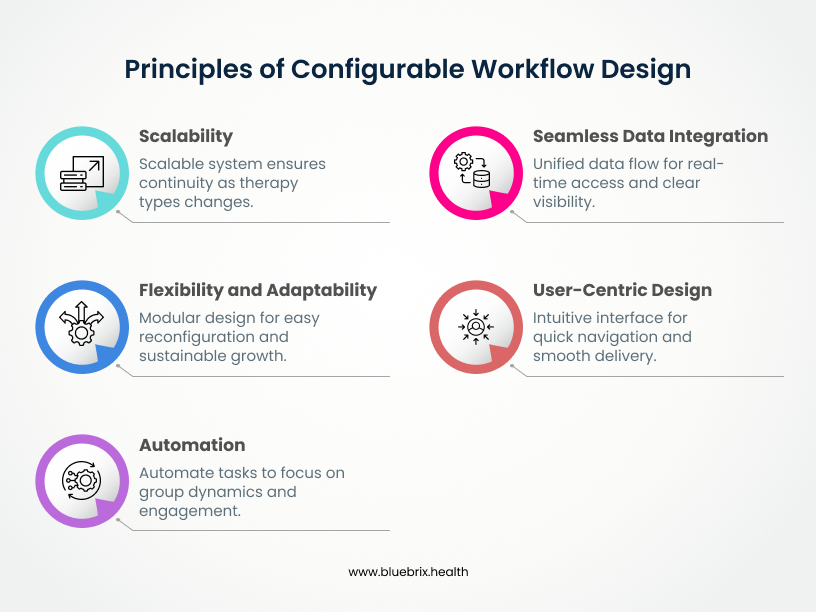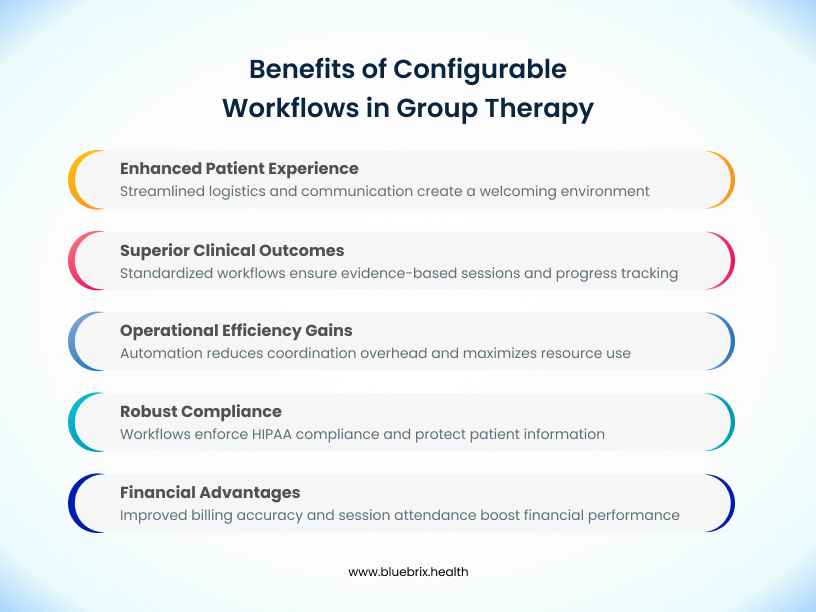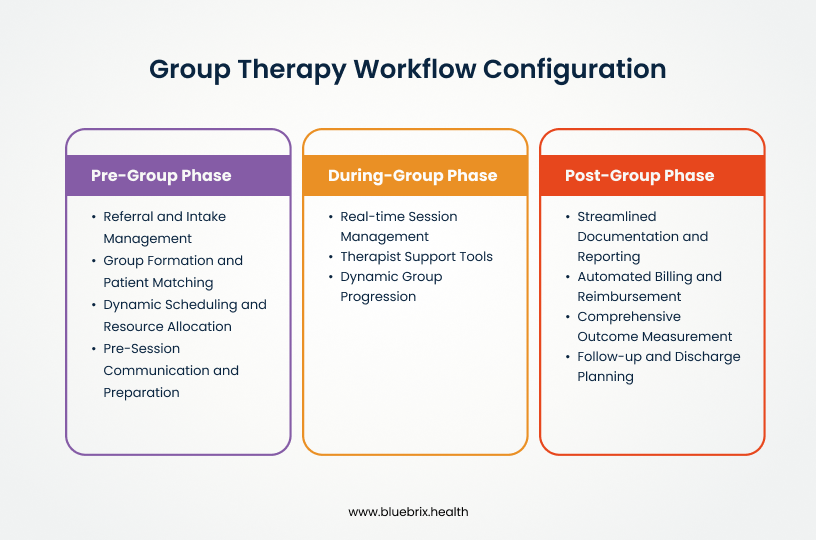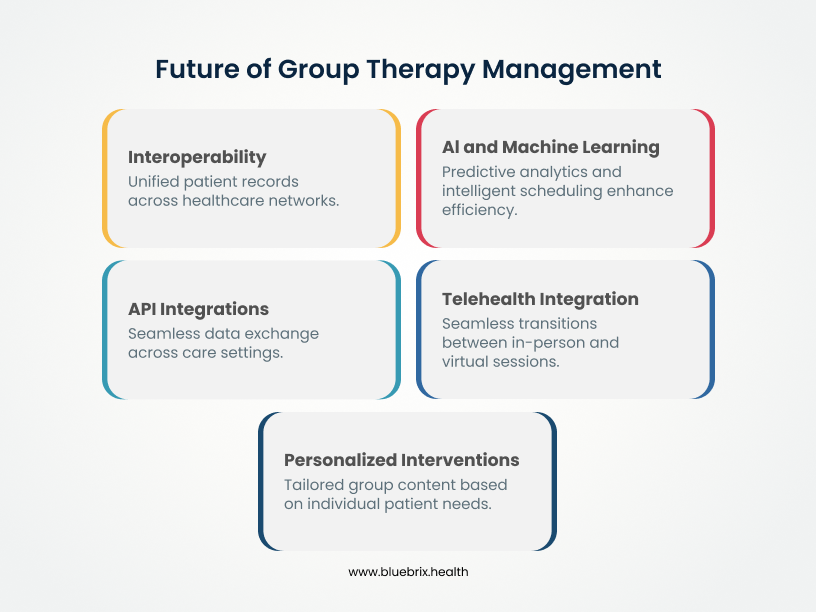This blog is all about configurable workflows and their profound impact on patient outcomes, operational efficiency, and financial health. We will explore implementation strategies and best practices that behavioral health providers, administrators, and clinicians can adopt to transform their group therapy operations.

Group therapy has long been recognized as a powerful and cost-effective modality in behavioral health. It offers unique therapeutic benefits, fostering a sense of community, shared experience, and mutual support that individual therapy often cannot replicate. From addiction recovery to anxiety management and trauma processing, groups provide a dynamic environment for healing and growth. However, the increasing demand for these services also brings significant challenges in managing complex group dynamics, logistics, and administrative overhead. Let’s discuss in detail.
Core Components of a Group Therapy
Group therapy adds a layer of complexity to clinical operations in behavioral health settings. Coordinating sessions across multiple cohorts, managing facilitator schedules, documenting care for each participant, and handling group-based billing require thoughtful planning and efficient processes. With increasing demand for services and limited staff bandwidth, inefficiencies can lead to delayed care, administrative backlogs, and provider fatigue.

A typical group therapy encompasses numerous stages; from the moment a patient is referred to the clinic to their post-discharge follow-up. Key touchpoints and data flows include:
- Referral & Intake: Initial contact, screening, and demographic data collection.
- Assessment & Matching: Clinical evaluation, group readiness, and appropriate group placement.
- Scheduling & Logistics: Session planning, room allocation, and therapist assignments.
- Session Delivery: Attendance tracking, real-time note-taking, and intervention logging.
- Documentation & Reporting: Progress notes, discharge summaries, and outcome tracking.
- Billing & Reimbursement: Coding, claim submission, and payment processing.
- Follow-up & Aftercare: Post-discharge communication and continuity of care planning.
Why do you need configurable workflows?
Because no two groups are the same—and your EHR should know that.
The stark contrast between configurable and static systems lies in their adaptability. Static systems are often built with fixed processes that are difficult and costly to change. This forces clinics to alter their operations to fit the software, leading to inefficiencies and frustration. Configurable systems, conversely, empower administrators and clinicians to:
- Adapt to changing regulations: Easily update forms and protocols to maintain compliance.
- Respond to evolving patient needs: Modify intake processes or group types as patient demographics shift.
- Implement new clinical protocols: Integrate new evidence-based practices seamlessly into workflows. This flexibility ensures that your system remains a valuable asset, not a bottleneck.

Here’s how configurable workflows directly support the core pillars of operational success in group therapy clinics:
Enhancing Patient Access and Experience
Efficient workflows directly translate to better patient access. Streamlined intake processes reduce wait times, making it easier for individuals to begin their healing journey. Automated reminders and clear communication ensure patients are prepared for sessions, improving attendance and engagement. Ultimately, a smooth operational flow contributes to a positive patient experience, fostering trust and continuity of care.
Mitigating Staff Burnout and Improving Focus
Behavioral health professionals often face overwhelming administrative burdens. Inefficient workflows mean more time spent on paperwork, scheduling, and data entry, and less time on direct patient care. This can lead to significant staff burnout, reduced job satisfaction, and high turnover rates. By automating repetitive tasks and streamlining processes, configurable workflows free up clinicians to focus on what they do best: providing compassionate and effective therapy.
Driving Financial Sustainability and Growth
Optimizing resource utilization, such as therapist time and group room availability, ensures that your clinic operates at peak capacity. Furthermore, accurate and timely billing, facilitated by automated coding and claim submission, maximizes reimbursement and reduces revenue leakage. By improving efficiency, clinics can increase patient volume without proportionally increasing overhead, driving sustainable growth.
Ensuring Regulatory Compliance and Risk Management
The behavioral health sector is heavily regulated, with strict requirements for documentation, privacy (HIPAA), and billing. Inefficient manual processes are prone to errors, increasing the risk of non-compliance, audits, and legal issues. Configurable workflows enable standardized documentation, automated audit trails, and consistent data integrity, significantly reducing these risks and ensuring your clinic remains compliant. Also, configurable user roles ensure that each stakeholder—therapists, admins, billing staff, support teams accesses only what they need.
Key Stages of Group Therapy Workflow: Configuration Opportunities

Stage 1: Pre-Group Phase – Setting the Stage for Success
This is where the foundation of effective group therapy is laid. Before any session begins, clinics must efficiently manage referrals, determine group eligibility, match patients thoughtfully, and set up the right logistical framework. Configurable workflows at this stage ensure that the right patients are placed in the right groups, fully informed and prepared to begin their therapeutic journey.
1. Referral and Intake Management
- Customizable intake forms and screening questionnaires: Tailor forms to gather specific information relevant to group therapy, including readiness assessments and past group experiences.
- Automated eligibility checks and pre-assessments: Automatically verify insurance eligibility and flag patients who meet specific criteria for certain groups.
- Configurable triage and prioritization rules: Go beyond basic eligibility checks by setting rules that prioritize urgent referrals, high-risk patients, or specific populations (e.g., youth, veterans) for group placement.
- Streamlined referral source tracking: Easily track where referrals originate, helping to optimize marketing efforts and referral partnerships.
2. Group Formation and Patient Matching
- Configurable criteria for group placement: Define rules for matching patients to groups based on diagnosis, age, gender, specific therapeutic goals, or even personality traits.
- Conflict of interest checks (configurable): Set up intelligent rules to flag potential conflicts—like family members being assigned to the same group or patients matched with therapists they’ve seen individually in the past.
- Tools for assessing group readiness and dynamics: Utilize integrated assessments to gauge a patient’s suitability for group therapy and predict potential group dynamics.
- Automated waitlist management: Automatically add patients to waitlists for specific groups and notify them when a spot becomes available.
3. Dynamic Scheduling and Resource Allocation
- Flexible group scheduling (fixed vs. rolling admission): Configure schedules for open-ended, rolling admission groups or closed, fixed-term groups.
- Automated room assignment and therapist availability checks: The system can automatically assign available rooms and ensure therapists are not double-booked.
- Integrated calendar management: Synchronize group schedules with individual therapist calendars and clinic-wide calendars.
4. Pre-Session Communication and Preparation
- Automated appointment reminders (SMS, email): Reduce no-shows with configurable, automated reminders sent directly to patients.
- Automated communication workflows (beyond reminders): Trigger welcome emails, follow-up messages if intake tasks are incomplete, and alerts to assigned therapists when a new patient joins their group.
- Delivery of preparatory materials (group rules, topics): Automatically send welcome packets, group rules, or pre-reading materials to new members.
- Secure pre-group assessments or surveys: Collect pre-session data or feedback securely through integrated patient portals.
Stage 2: During-Group Phase – Optimizing Session Delivery
Once a group is up and running, the focus shifts to real-time session management, clinician support, and dynamic group progression. This phase is all about execution—ensuring that sessions run smoothly, documentation is efficient, and both group and individual needs are continuously addressed. Configurable workflows at this stage help clinicians stay present in the session while capturing essential data, tracking group dynamics, and responding quickly to any clinical or operational issues.
1. Real-time Session Management
- Digital attendance tracking with automated alerts: Easily mark attendance and configure alerts for missed sessions or patterns of non-attendance.
- Configurable progress notes templates (SOAP, DAP, etc.): Use pre-built or custom templates to ensure consistent, comprehensive, and compliant documentation.
- Easy logging of interventions and observations: Quickly record specific interventions used and key observations about group dynamics or individual participation.
- Configurable data entry validation rules: Maintain documentation quality by setting rules for required fields, standardized data formats, and logical error checks—minimizing downstream billing or compliance issues.
2. Therapist Support Tools
- Access to patient history and treatment plans within the session interface: Clinicians can quickly review relevant patient information without leaving the group note.
- Configurable session outlines and topic prompts: Provide therapists with structured outlines for sessions, ensuring consistency across groups and helping new facilitators.
- Integrated crisis protocols and emergency contacts: Immediate access to critical information and protocols in case of an emergency during a session.
- Configurable alert system for therapist support: Beyond emergency flags, configure alerts for emerging clinical patterns—such as a patient repeatedly showing signs of distress, major shifts in group cohesion, or upcoming treatment plan review dates.
3. Dynamic Group Progression
- Tracking group cohesion and individual participation: Monitor qualitative and quantitative data points related to group dynamics.
- Adjusting group goals and interventions based on real-time data: Use insights from session notes and observations to adapt the group’s direction.
- Integration with telehealth platforms (configurable options): For hybrid or remote delivery, enable seamless integration with third-party telehealth platforms, supporting features like screen sharing, secure messaging, breakout rooms, and digital whiteboards—all within a secure, compliant session environment.
Stage 3: Post-Group Phase – Ensuring Continuity and Accountability
The end of a session—or even the end of a treatment cycle—is not the end of care. The post-group phase plays a critical role in reinforcing therapeutic gains, capturing clinical outcomes, and preparing patients for next steps. Whether transitioning to individual care, following up on progress, or closing the loop with documentation and billing, this stage ensures long-term continuity, compliance, and insight into both clinical and operational performance. Configurable workflows make these processes more efficient and sustainable across the board.
1. Streamlined Documentation and Reporting
- Automated generation of session summaries and discharge reports: Reduce manual effort by automatically compiling information into comprehensive reports.
- Customizable reporting dashboards for clinical oversight: Gain insights into group performance, patient progress, and therapist workload through intuitive dashboards.
- Secure storage and retrieval of all group-related data: Ensure all documentation is securely stored and easily accessible for audits or future reference.
- Configurable data retention policies: Define how long group therapy records, session notes, and assessments are retained, archived, or purged to stay compliant with HIPAA, state-specific laws, and organizational policies.
2. Automated Billing and Reimbursement
- Integration with billing systems for accurate coding: Automatically generate appropriate CPT codes based on session type and duration.
- Automated claim generation and submission: Expedite the billing cycle by automating the creation and submission of claims.
- Tracking of co-pays and deductibles: Monitor patient financial responsibilities and automate payment reminders.
3. Comprehensive Outcome Measurement
- Configurable outcome measures and assessment tools: Implement standardized or custom assessments to track patient progress and group effectiveness.
- Automated data collection and analysis for group effectiveness: Collect and analyze data on key metrics, providing evidence of therapeutic impact.
- Visualization of patient progress over time: Present outcome data in clear, graphical formats for both clinicians and patients.
- Patient feedback mechanisms (configurable surveys): Deploy automated, configurable post-group surveys to capture patients’ perspectives on group effectiveness, therapist performance, and overall experience—driving continuous improvement.
- Integration with research and development (R&D) workflows: For academic or enterprise clinics, support configurable data anonymization and export workflows, enabling participation in clinical studies or internal research initiatives while maintaining full compliance.
4. Follow-up and Discharge Planning
- Automated follow-up reminders and check-ins: Schedule automated communications to support patients post-discharge.
- Configurable follow-up cadence and content: Tailor the frequency, timing, and messaging of follow-up touchpoints based on individual discharge plans, diagnosis, or care level—ensuring relevance and adherence.
- Configurable discharge summaries and aftercare recommendations: Generate personalized discharge plans with recommendations for continued care.
- Seamless transition to individual therapy or other services: Facilitate smooth handoffs to other clinicians or programs within or outside the clinic.
The Future of Group Therapy Management: Emerging Trends

- AI and Machine Learning in Workflow Optimization – The future promises even greater efficiency through AI and machine learning. These technologies will enable predictive analytics for group success, intelligent scheduling that optimizes therapist and room utilization, and even personalized recommendations for group interventions based on patient data.
- Seamless Telehealth Integration – The shift to telehealth is permanent. Future configurable workflows will offer even more robust support for hybrid group models, allowing seamless transitions between in-person and virtual sessions, and ensuring secure, engaging online experiences.
- Personalized Group Interventions – Leveraging advanced data analytics, configurable systems will increasingly support personalized group interventions. This means adapting group content and approaches based on individual patient needs and progress within the group, leading to more targeted and effective therapy.
- Configurable API Integrations for Holistic Workflows – Configurable API integrations with external systems like third-party EHRs, patient engagement platforms, analytics tools, and even custom-built clinical apps will enable seamless data exchange across care settings. Clinics can build workflows that reflect their unique tech ecosystem, reducing redundancy and improving care continuity.
- Enhanced Interoperability and Ecosystem Integration – The healthcare ecosystem is becoming increasingly interconnected. Future workflows will emphasize enhanced interoperability, allowing seamless data exchange with broader healthcare networks and creating unified patient records across various care settings.
Conclusion: Embracing Efficiency for Better Care
Configurable group therapy workflows are not just about administrative convenience; they are more about fundamentally transforming how behavioral health clinics operate. They empower clinics to enhance patient access, improve clinical outcomes, boost staff morale, ensure compliance, and drive financial sustainability. The time to invest in intelligent, adaptable technology is now. Behavioral health leaders must prioritize efficiency as a cornerstone of quality care, recognizing that optimized workflows directly contribute to better patient lives and healthier practice.
The journey to optimal efficiency is a continuous one, requiring commitment and a willingness to embrace innovation. However, the rewards—in the form of improved patient care, empowered staff, and a thriving practice—are profound and well worth the investment. Experience the difference of truly configurable group therapy workflows with blueBriX’s leading behavioral health EHR. Our intuitive platform is designed to streamline operations, enhance patient care, and empower your team. Learn more & request a demo today!